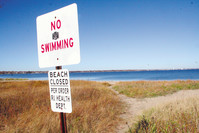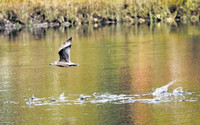For years, fishermen have tried their luck off the north beach of Conimicut. And when the blues and stripers are running, they can get lucky.
But swimmers usually don’t press their luck on that …
This item is available in full to subscribers.
We have recently launched a new and improved website. To continue reading, you will need to either log into your subscriber account, or purchase a new subscription.
If you are a current print subscriber, you can set up a free website account by clicking here.
Otherwise, click here to view your options for subscribing.
Please log in to continue |
|


For years, fishermen have tried their luck off the north beach of Conimicut. And when the blues and stripers are running, they can get lucky.
But swimmers usually don’t press their luck on that side of the point. That’s because Narragansett Bay waters north of an imaginary line between Nyatt Point in Barrington and Conimicut Point in Warwick are supposed to be polluted. Shellfishing north of that line is prohibited, and the upper bay or Providence River is also off limits to fishing trawlers.
Now the supposition that waters north of Conimicut are polluted is being challenged – not that you’re going to find quahoggers working off Gaspee Point or the Rhode Island Yacht Club, or see schools of menhaden scooped up at the mouth of Pawtuxet Cove. But you could see swimming on both sides of Conimicut Point, according to Jonathan Stone, executive director of Save the Bay.
Stone thought that was possible as Watershed Counts, a program co-coordinated by the Coastal Institute at the University of Rhode Island and the Narragansett Bay Estuary Program, released its report spotlighting cities by the bay and urban waters.
The 30-page report offers a case study of Sabin Point in East Providence and concludes on the basis of monitored bacteria levels since 2010 that “with a little work, this could be the first licensed saltwater beach in the greater Providence area.”
Stone thought that possible, and if Sabin Point Beach could meet the strict standards set by the Rhode Island Department of Health, he imagined Conimicut Beach north would also pass tests. The issue, he said, is often community resources and funding for a lifeguard.
The underlying message to such considerations, whether action is taken or not, is that upper bay waters are clearer than they have been in a long time. That was the “good news” of Monday’s announcement at Save the Bay’s offices, with the glistening bay for a backdrop.
There was also the “not so fast to rejoice” message of climate change; increasing development in the bay watershed, 60 percent of which is in Massachusetts; storm water releases of nutrients; and “hardened shorelines” that don’t allow for environmental purification of waters. There are other challenges, too, such as upper bay sediments laced with metals and PCBs accumulated from decades of manufacturing along rivers feeding the bay.
Stone cited climate change as having a “profound impact” on the bay’s water quality. He said with more intense storms, more nitrogen and hydrocarbons are washed into the bay. This can trigger a cycle of algae blooms followed by their death and decomposition, resulting in oxygen depletion and fish kills.
Climate change is also resulting in increased water temperatures that can stimulate algae growth. Sea level rise is also cited in the report, which forecasts that between extreme weather events and a rise in sea level, “most of the coastal towns on the east coast will see triple the number of flooding events by 2030.”
Funding is yet another challenge. Stone said the state and municipalities have limited resources to underwrite projects such as sewer extensions and storm water management. Nonetheless, he says, government should be held accountable.
Tom Borden, program director of the Narragansett Bay Estuary Program, cited the strides made since the Narragansett Bay Commission brought online its subterranean systems of tunnels that serve as reservoirs for combined storm and sewer wastewater during periods of heavy precipitation. The wastewater is treated after the event before the effluent reaches the bay.
“Bacteria levels are down,” he said, “urban beaches can open.”
The esthetic and recreational attributes of clean waters in urban areas were mentioned as well as the spin-off of economic benefits.
“Access to Pawtucket’s urban parks and waters, along with a national spotlight on the Blackstone River’s heritage, is a significant investment and will help drive private development, improve the housing market and draw in new events and tourists,” Cheryl Sullivan, interim executive director of the Pawtucket Foundation, a member of the Watershed Counts partnership, said in a statement.
“Partners in the watershed are making investments that have important local impacts, but these isolated efforts need help to take on the big issues such as improving water quality and adapting to climate change,” said Nicole Rohr, assistant director of the Coastal Institute. “Unfortunately, the scale of effort that is needed is not currently in development, but more elected and appointed leaders are starting to make the important link between the environment and the economy.”
1 comment on this item Please log in to comment by clicking here
JohnStark
25 years ago, the thought of catching stripers off India Point was laughable. Now it's a common practice. I even see more and more scallop shells in the upper bay. It is, indeed, much cleaner. Big kudos to all involved!
Thursday, November 5, 2015 Report this